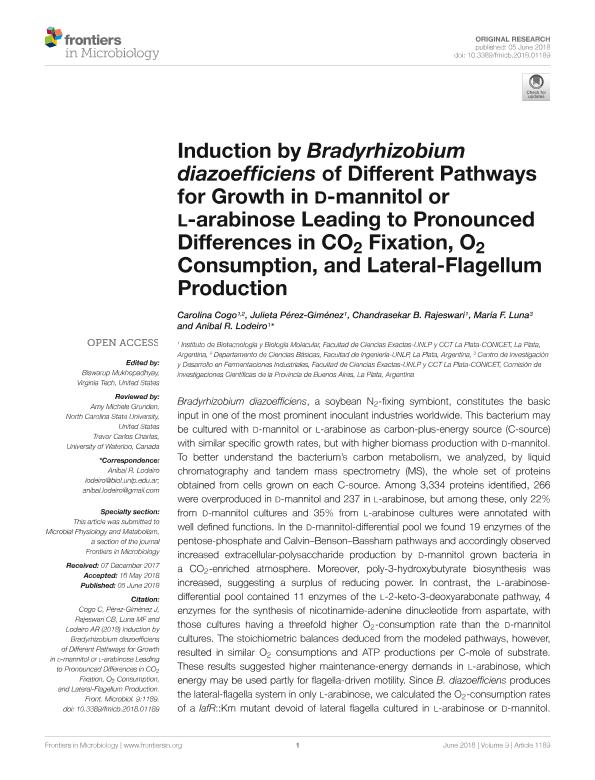Artículo
Induction by Bradyrhizobium diazoefficiens of different pathways for growth in D-mannitol or L-arabinose leading to pronounced differences in CO2 Fixation, O2 consumption, and lateral-flagellum production
Cogo, Carolina ; Pérez Giménez, Julieta
; Pérez Giménez, Julieta ; Rajeswari, Chandrasekar B.; Luna, Maria Flavia; Lodeiro, Anibal
; Rajeswari, Chandrasekar B.; Luna, Maria Flavia; Lodeiro, Anibal
 ; Pérez Giménez, Julieta
; Pérez Giménez, Julieta ; Rajeswari, Chandrasekar B.; Luna, Maria Flavia; Lodeiro, Anibal
; Rajeswari, Chandrasekar B.; Luna, Maria Flavia; Lodeiro, Anibal
Fecha de publicación:
06/2018
Editorial:
Frontiers Research Foundation
Revista:
Frontiers in Microbiology
ISSN:
1664-302X
Idioma:
Inglés
Tipo de recurso:
Artículo publicado
Clasificación temática:
Resumen
Bradyrhizobium diazoefficiens, a soybean N2-fixing symbiont, constitutes the basic input in one of the most prominent inoculant industries worldwide. This bacterium may be cultured with D-mannitol or L-arabinose as carbon-plus-energy source (C-source) with similar specific growth rates, but with higher biomass production with D-mannitol. To better understand the bacterium's carbon metabolism, we analyzed, by liquid chromatography and tandem mass spectrometry (MS), the whole set of proteins obtained from cells grown on each C-source. Among 3,334 proteins identified, 266 were overproduced in D-mannitol and 237 in L-arabinose, but among these, only 22% from D-mannitol cultures and 35% from L-arabinose cultures were annotated with well defined functions. In the D-mannitol-differential pool we found 19 enzymes of the pentose-phosphate and Calvin-Benson-Bassham pathways and accordingly observed increased extracellular-polysaccharide production by D-mannitol grown bacteria in a CO2-enriched atmosphere. Moreover, poly-3-hydroxybutyrate biosynthesis was increased, suggesting a surplus of reducing power. In contrast, the L-arabinose-differential pool contained 11 enzymes of the L-2-keto-3-deoxyarabonate pathway, 4 enzymes for the synthesis of nicotinamide-adenine dinucleotide from aspartate, with those cultures having a threefold higher O2-consumption rate than the D-mannitol cultures. The stoichiometric balances deduced from the modeled pathways, however, resulted in similar O2 consumptions and ATP productions per C-mole of substrate. These results suggested higher maintenance-energy demands in L-arabinose, which energy may be used partly for flagella-driven motility. Since B. diazoefficiens produces the lateral-flagella system in only L-arabinose, we calculated the O2-consumption rates of a lafR::Km mutant devoid of lateral flagella cultured in L-arabinose or D-mannitol. Contrary to that of the wild-type, the O2-consumption rate of this mutant was similar on both C-sources, and accordingly outcompeted the wild-type in coculture, suggesting that the lateral flagella behaved as parasitic structures under these conditions. Proteomic data are available via ProteomeXchange with identifier PXD008263.
Palabras clave:
BRADYRHIZOBIUM
,
CBB PATHWAY
,
FLAGELLA
,
L-KDA PATHWAY
,
O2 CONSUMPTION
,
PP PATHWAY
Archivos asociados
Licencia
Identificadores
Colecciones
Articulos(CCT - LA PLATA)
Articulos de CTRO.CIENTIFICO TECNOL.CONICET - LA PLATA
Articulos de CTRO.CIENTIFICO TECNOL.CONICET - LA PLATA
Articulos(CINDEFI)
Articulos de CENT.DE INV EN FERMENTACIONES INDUSTRIALES (I)
Articulos de CENT.DE INV EN FERMENTACIONES INDUSTRIALES (I)
Articulos(IBBM)
Articulos de INST.DE BIOTECNOLOGIA Y BIOLOGIA MOLECULAR
Articulos de INST.DE BIOTECNOLOGIA Y BIOLOGIA MOLECULAR
Citación
Cogo, Carolina; Pérez Giménez, Julieta; Rajeswari, Chandrasekar B.; Luna, Maria Flavia; Lodeiro, Anibal; Induction by Bradyrhizobium diazoefficiens of different pathways for growth in D-mannitol or L-arabinose leading to pronounced differences in CO2 Fixation, O2 consumption, and lateral-flagellum production; Frontiers Research Foundation; Frontiers in Microbiology; 9; JUN; 6-2018; 1-16
Compartir
Altmétricas



